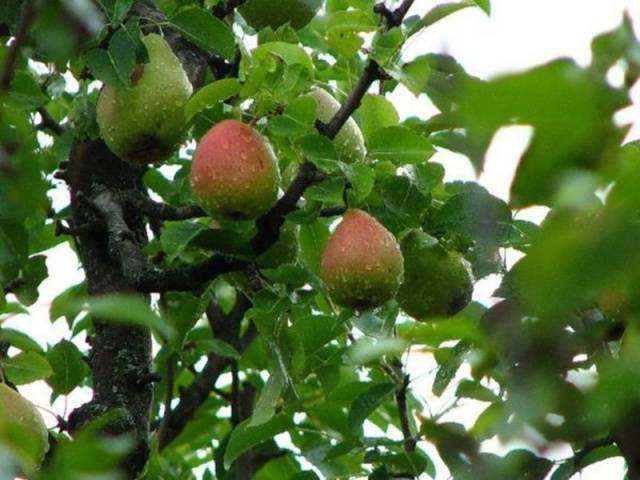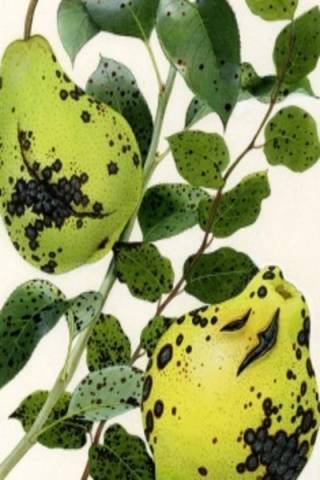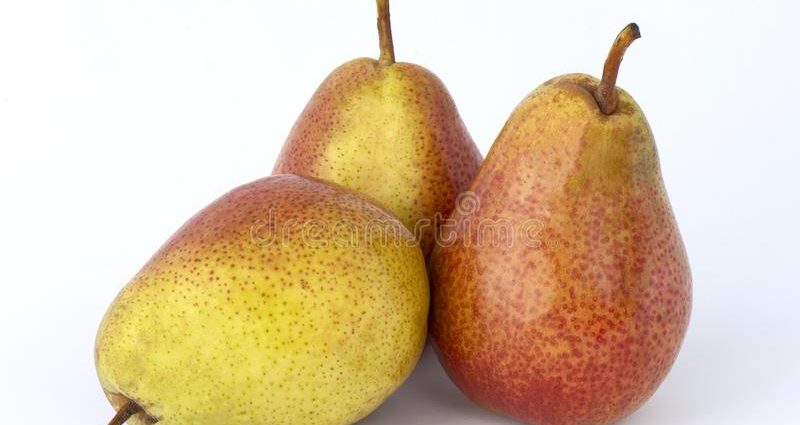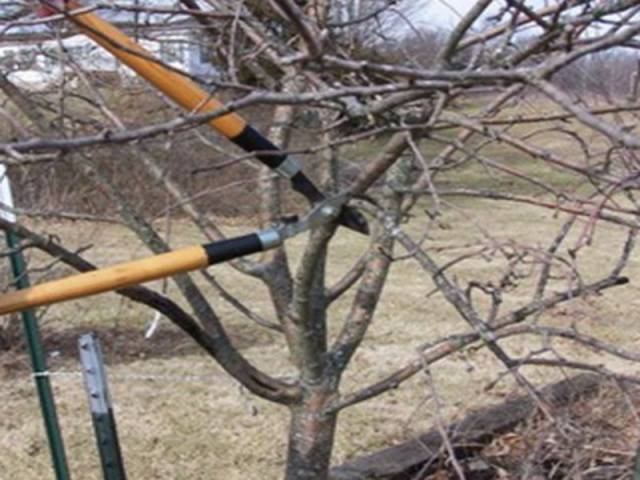Contents
Summer cottages are, as a rule, modest in size. Therefore, fruit trees for the garden are selected small, beautiful and productive.
Characteristic of the variety
Pear Trout is an ideal fruit tree for a small area. The tallest trees are not higher than 6 m. The pear trunk has a classic dark brown color. Grayish-brown branches form a spreading crown. A distinctive feature of the Trout variety is small leaves with a rich green glossy surface, yellow veins that look like an intricate decor.

The first flowers appear in early April. The Trout pear is not self-fertile. The first harvest can be taken after 3-4 years. It can be assumed that it was thanks to the elegant color of pears that this variety was named Trout. The yellow color and the abundance of bright red dots give the Trout fruits a colorful look. The peel of pears is thin and smooth, and the fruits themselves weighing 130-150 g have a traditional elongated shape. Fruit description: soft and juicy white flesh, sweet taste with a hint of cinnamon.

You can start harvesting Trout pears from mid-September, and without waiting for the fruit to fully ripen. Plucked fruits are easily stored for about a month.
Planting and care
It is desirable to select Trout pear seedlings for planting at the age of one to two years. When choosing a tree of the Trout variety, special attention should be paid to the branches of the tree: they must be intact, without visible damage. With a small amount of force applied, the twigs bend rather than break. The optimal root length is 60-80 cm.
However, you should not plant a pear in a bare area, blown from all sides, as seedlings of this variety do not like strong winds.
The most suitable location for the Trout pear is the southern or southwestern part of the summer cottage.
When forming a garden, the dimensions of the future pear crown must be taken into account. Therefore, in order to exclude close contact with neighbors, Trout is planted at a distance of 4 m from the nearest trees.
It is also desirable to exclude areas with a high location of groundwater. Regarding the quality of the soil, Trout has no special requests. Even clay soils are suitable. But, of course, poor lands are pre-fertilized, preferably in the fall.
Planting a seedling
To fertilize the soil when digging the site in the fall, it is recommended to use organic compounds. Based on a square meter of area, 3 kg of litter / manure, 3,5 kg of compost, 1 kg of ash are taken.
It makes sense to dig a hole for a pear seedling in the fall: one meter deep and about 80 cm in diameter. Moreover, the top fertile soil layer is laid separately. The right time for preparatory work is after the foliage has fallen and before the first frost.
If in the fall it was not possible to prepare the soil and dig a hole, then in the spring the following work is carried out:
- two weeks before planting, a hole of the appropriate size is dug, and two buckets of sand and humus, a glass of superphosphate and 3 tbsp. l potassium sulfate;
- lime is diluted in ten liters of water and the solution is poured into a pit.
Before planting, pear seedlings should be kept in a cool, shady place.
The cut point is carefully processed with garden pitch. Immediately after these manipulations, the tree is placed in a bucket of water, where it is kept for at least an hour.
Landing stages
- The fertile part of the soil is mixed with water and ash. The roots of the Forel pear variety are lowered into the resulting mixture.
- Drainage is laid out at the bottom of the pit (small stones, twigs, pebbles). Part of the fertile soil spills out on top of the drainage layer in the form of a hill. A wooden stake is driven in slightly to the side of the center of the pit.
- A seedling of this pear variety is lowered into a hole, the roots are carefully straightened. The pit is filled first with a fertile composition, and then with the usual one.
- As soon as two-thirds of the pit is filled, it is necessary to pour a bucket of water. When the water is absorbed, completely fill the hole with the remaining soil.
After shrinkage of the earth, the neck of the seedling of the Trout variety should be at ground level. It is not allowed to bury it.
In areas with a high location of groundwater (at a distance of a meter from the surface), it is necessary to make a thick layer of drainage, approximately 40 cm.
Crown formation
It takes five to six years for the crown of the Trout variety to acquire its final shape. At this time, the tree already has 5 skeletal branches.
The gradual stage of crown formation can be defined as follows:
- in early July, the three strongest shoots are distinguished, which are located at intervals of 15-20 cm. The lower tier of the crown is formed from them. When cutting a Trout pear, it must be borne in mind that the central conductor should always be 20-25 cm higher than other branches:
- then sanitary pruning is carried out – weak branches and shoots directed inside the crown are removed;

- starting from the third year, they begin to form the crown of the Trout pear variety. To do this, do not touch 3-4 branches that evenly extend from the crown (these are skeletal branches). The remaining branches are shortened by two thirds;
- in the fourth and fifth years, at the base of the skeletal branches, lateral, upward-growing branches of the second order are removed.
It is considered that the crown of the Trout variety is finally formed if it has clearly defined skeletal branches, there are no large parallel branches and there are no branches that cross. In general, the tree should look proportionate.
There is an opinion that the thinning of the Trout variety does not affect the yield. Therefore, the tops are necessarily removed, and the vertical branches are shortened and “transformed” into fruit-bearing ones. To do this, the branch is tilted and twisted under the lower branches. You can apply this practice from the fourth, fifth year after planting the Trout variety.
Watering and fertilizing the soil
In the summer, it is recommended to water the seedling with warm water. Moreover, it is necessary to literally fill in the Trout variety so that the soil settles and the soil is well saturated.
Starting from the second year, watering the pear is carried out once or twice a month. After watering, the soil must be loosened, weeded and mulched. Inside the trunk circle, you can put straw, sawdust, mowed grass. A sufficient layer of mulch is about 4-6 cm.
In autumn, superphosphate and potassium chloride are added. It also does not interfere with the introduction of wood ash into the soil when digging the trunk circle.
Harvest
Finally, Trout fruits ripen at the end of October. Mature pears of the Trout variety have a yellowish color with elegant red specks (as in the photo). In cool rooms, they can lie for about a month, and at normal room temperature, pears last one and a half to two weeks.
If you want to stock up on fruits for the winter, then it is customary to shoot Trout pears unripe. In this case, if the correct storage conditions are provided, the pears will lie for about six months.
Preparation for winter
The most important stage of work in the autumn period is to insulate the Trout pear for the winter. The traditional method is the formation of a “fur coat” for the trunk. For this purpose, felt, straw are wrapped around the trunk and fixed with burlap. Some summer residents practice wrapping a pear trunk with roofing material, but this only makes sense in regions with cold and little snowy winters.
Do not forget about the winter guests-rodents. To protect pears from mice, hares can be wrapped around the trunks with a metal mesh or spruce forest (with the branches placed with the needles down).
Diseases and pests
The most common diseases of the Trout variety include “fruit rot”. This fungal infection spreads especially quickly in humid and warm weather. Fruits are covered with dark brown spots, rot. Moreover, pears do not fall off, but remain on the stalks, infecting neighboring fruits. As a preventive measure, it is necessary to spray Trout pears with Fitosporin-M a month before harvesting. Be sure to remove damaged fruits, twigs, foliage and burn.


Scab is a fungal disease that affects leaves, shoots, pears. It appears as spots and black dots. Leads to shedding of flowers, leaves. Pears are tied small and do not develop. Control measures – in the fall, all foliage is carefully removed, in the spring, before bud break, the tree is irrigated with Bordeaux mixture.


The main pest of the Trout pear is the aphid, which sucks the juices from the leaves and young shoots. This causes the leaves to fall off. In early spring, it is advisable to spray this variety of pears with Bordeaux liquid, whiten the trunk.
An elegant pear of the Trout variety will adequately decorate any suburban area. It belongs to late varieties and therefore tasty fruits can be enjoyed in late autumn. And with proper storage, Trout pear will decorate the New Year’s table.











